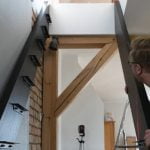Is furniture considered home improvement? When it comes to enhancing the appearance and functionality of a living space, the role of furniture cannot be overlooked. In this article, we will delve into the impact of furniture on home improvement projects and explore its importance in creating a comfortable and aesthetically pleasing environment.
Home improvement encompasses any changes made to a residence to enhance its overall appearance, increase its value, or improve the quality of life for its occupants. This can include renovations, remodeling, and additions that aim to upgrade various aspects of a home. One crucial element of home improvement is furniture, which plays a significant role in defining the ambiance and functionality of a living space.
The furniture in a home not only serves practical purposes but also contributes to the overall aesthetic appeal. From the choice of materials and designs to the arrangement of pieces within a room, furniture can greatly impact the atmosphere and style of a living space. As such, selecting the right furniture is essential in creating an inviting and visually appealing environment within a home.
The Definition of Furniture and Its Role in Home Improvement
When discussing home improvement, it is important to consider the various elements that contribute to making a house feel like a home. One such element is furniture, which plays a crucial role in enhancing the functionality and aesthetic appeal of the living space. Furniture refers to movable objects intended to support various human activities such as seating, sleeping, and storage.
This can include items such as chairs, tables, beds, cabinets, and sofas, among others. In the context of home improvement, furniture serves as an essential component in creating a comfortable and visually appealing interior.
The Functionality of Furniture in Home Improvement
Furniture not only provides practical solutions for daily living but also contributes significantly to the overall organization and layout of a home. Choosing the right furniture pieces can help maximize space utilization, improve accessibility, and create a more efficient environment. For example, incorporating multifunctional furniture in small living spaces can optimize the available area and make it more livable. Furthermore, selecting ergonomic furniture that promotes good posture and comfort can positively impact the well-being of occupants.
The Aesthetic Role of Furniture in Home Improvement
In addition to its functional benefits, furniture also plays a crucial role in shaping the visual appeal of a home. The style, design, color, and material of furniture have the power to set the tone for an entire living space.
Whether aiming for a modern, minimalist look or a cozy, traditional ambiance, choosing furniture that complements the overall interior design is vital for achieving desired aesthetic outcomes in home improvement projects. The strategic placement of furniture can also influence spatial perception and create visually balanced and harmonious environments within the home.
The Impact of Furniture on the Overall Aesthetic of a Home
Furniture plays a crucial role in determining the overall aesthetic of a home. The type, style, and arrangement of furniture can significantly impact the look and feel of a space.
For example, choosing sleek, modern furniture can create a contemporary and minimalist ambiance, while opting for vintage or antique pieces can bring a sense of warmth and nostalgia to a room. Additionally, the color and material of the furniture also contribute to the overall aesthetic – bold, vibrant colors can make a statement in a room, while natural materials like wood or rattan can add an organic and rustic charm.
In interior design, furniture is often considered as both functional and decorative. Not only does it serve practical purposes such as providing seating or storage solutions, but it also serves as an artistic expression that enhances the visual appeal of a space. The right furniture pieces can tie together different elements within a room and create a cohesive look that reflects the homeowner’s personal style.
Furthermore, the placement and arrangement of furniture also play a key role in shaping the aesthetic of a home. Properly positioned furniture can optimize traffic flow within a space and maximize functionality while creating visually pleasing focal points. Whether it’s creating an inviting conversation area in the living room or arranging dining furniture to facilitate social interaction during meals, strategic placement is essential in achieving an aesthetically pleasing home environment.
| Role | Impact |
|---|---|
| Determining overall aesthetic | Significantly impacts look and feel of space |
| Function & decoration | Serves practical purposes as well as an artistic expression |
| Placement & arrangement | Key role in shaping the aesthetic within rooms |
How Furniture Can Add Value to a Home
When it comes to adding value to a home, many people may think of large-scale renovations such as kitchen or bathroom upgrades. However, the right furniture can also significantly increase the value of a property. From increasing functionality to improving aesthetics, furniture plays a key role in enhancing the overall appeal of a home.
Functionality and Practicality
One way furniture adds value to a home is through its functionality and practicality. Well-chosen pieces can maximize space in a room, provide necessary storage, or create designated areas for specific activities. For example, built-in shelving or storage units can add both visual appeal and practical storage solutions to a home, making it more attractive to potential buyers.
Enhancing Aesthetics
The aesthetic appeal of furniture cannot be understated when it comes to adding value to a home. High-quality, stylish pieces can elevate the look and feel of a space, making it more inviting and visually appealing. Additionally, the design and style of furniture can contribute to the overall aesthetic coherence of a home, creating a cohesive and harmonious atmosphere that potential buyers find attractive.
Increasing Comfort and Livability
Comfortable furniture that enhances the livability of a home can also add significant value. Pieces that promote relaxation and comfort, such as cozy sofas or ergonomic chairs, can make a space more enjoyable for homeowners and visitors alike. This increased comfort directly translates into higher perceived value for the property as a whole.
DIY Furniture Projects
When it comes to home improvement, many homeowners are looking for cost-effective solutions to enhance the aesthetic and functionality of their living spaces. DIY furniture projects have become a popular option for those seeking to make impactful changes without breaking the bank. By creating your own furniture pieces, you can customize them to fit your specific space and design preferences while saving money in the process.
Here are a few reasons why DIY furniture projects are considered a cost-effective home improvement solution:
- Cost Savings: One of the primary reasons DIY furniture projects are popular is because they offer significant cost savings compared to purchasing new furniture. By sourcing materials and building the pieces yourself, you can avoid high price tags often associated with store-bought furniture.
- Customization: DIY projects allow for complete customization, ensuring that the furniture pieces meet your specific size, style, and color requirements. This level of personalization can be hard to find with ready-made furniture options.
- Creative Expression: Engaging in DIY furniture projects provides an outlet for creative expression, allowing homeowners to showcase their skills and creativity through unique and one-of-a-kind pieces. It also offers a sense of accomplishment and pride in contributing to the design and functionality of their home.
Whether it’s building a new coffee table, refurbishing an old dresser, or constructing custom shelving units, DIY furniture projects offer homeowners the opportunity to improve their living spaces without breaking the bank. With careful planning and execution, these projects can result in cost-effective solutions that enhance both the beauty and functionality of a home.
The Role of Furniture in Renovations and Remodeling
When it comes to renovations and remodeling, furniture plays a crucial role in transforming the look and feel of a home. Whether it’s updating the style of a room or maximizing space, choosing the right furniture can make a significant impact on the overall outcome of a renovation project. In many cases, homeowners often overlook the potential that furniture has in enhancing the design and functionality of their living spaces.
One of the key aspects of including furniture in renovations is to ensure that it complements the new design or layout of the space. This means considering not only the style and aesthetics but also the size and scale of the furniture pieces. For example, when redesigning a living room to create an open concept layout, choosing furniture that is proportionate to the space can help maintain a cohesive and balanced look.
Furthermore, selecting multifunctional furniture can greatly contribute to making the most out of limited space during remodeling projects. Pieces such as ottomans with hidden storage, sofa beds, or modular shelving units can be excellent additions for maximizing functionality while adding a modern touch to any room.
| Role of Furniture | In Renovations & Remodeling |
|---|---|
| Transforms the look and feel | Contributing significantly to overall outcome |
| Complementing new design/layout | Consider style, scale, functionality |
| Multifunctional furniture choices | Adds modern touch while maximizing space |
Choosing the Right Furniture for Home Improvement Projects
When considering home improvement projects, choosing the right furniture plays a crucial role in achieving the desired outcome. Whether it’s a complete renovation or just a simple makeover, the selection of furniture can significantly impact the overall look and feel of a space. Here are some important factors to consider when choosing the right furniture for home improvement projects:
- Style and Theme: The chosen furniture should complement the style and theme of the home. Whether it’s modern, traditional, minimalist, or eclectic, selecting pieces that harmonize with the existing aesthetic will create a cohesive and polished look.
- Functionality: It’s essential to consider how the furniture will be used within a specific area. For instance, if it’s for a living room, comfort and durability may be prioritized. In a home office, functionality and storage options might take precedence.
- Size and Proportion: The scale of the furniture should be proportionate to the space it will occupy. Oversized pieces can make a room feel cramped, while undersized items may appear insignificant.
Additionally, considering eco-friendly options like sustainable materials or repurposed pieces can also contribute to environmentally conscious home improvement projects. Making informed choices regarding furniture not only enhances the visual appeal of a home but also contributes to creating functional and comfortable living spaces that support individual needs and preferences.
Conclusion
In conclusion, after examining the definition of home improvement and the impact of furniture on the overall aesthetic and value of a home, it is evident that furniture is indeed considered to be an essential aspect of home improvement. The role of furniture in renovations, remodeling, and DIY projects cannot be understated, as it contributes significantly to the functionality and visual appeal of a living space.
Whether it’s updating existing furniture or investing in new pieces, the right furniture can transform a house into a comfortable and inviting home.
Furthermore, the significance of choosing the right furniture for home improvement projects cannot be overlooked. The selection of appropriate pieces that complement the existing decor and layout can elevate the look and feel of a space while also adding value to the property. Additionally, DIY furniture projects offer a cost-effective solution for homeowners looking to personalize their living environment and increase their property’s marketability.
Ultimately, from enhancing aesthetics to increasing functionality and adding value, furniture plays an integral role in home improvement. Therefore, it is safe to say that when considering ways to improve a home, investing in quality furniture is not only acceptable but also highly recommended for achieving desired improvements in both appearance and functionality.
Frequently Asked Questions
Is Work From Home Furniture Tax Deductible?
Work from home furniture may be tax deductible if it is used exclusively for work purposes. To claim the deduction, you will need to calculate the percentage of your home used as a dedicated workspace and only deduct that portion of the cost.
Keep in mind that there are specific criteria and limitations set by the IRS, so it’s always best to consult with a tax professional for accurate advice on this matter.
How Do I Prove Home Improvements Without Receipts?
Proving home improvements without receipts can be challenging but not impossible. One way to prove home improvements without receipts is to provide evidence of the work done such as before and after photos, contractor agreements, bank statements showing payments to contractors or materials, and any other documentation that supports the improvement project.
It’s advisable to keep detailed records and document all home improvement projects whenever possible.
What Is the Difference Between Repair and Improvement?
The difference between repair and improvement lies in their purpose and scope. Repairs are typically done to fix or restore something that is damaged or not working properly, while improvements are made to enhance or add value to a property.
In terms of taxes, repairs are usually deducted in the year they occur while improvements are capitalized and their cost is recovered through depreciation over time. It’s important to understand this difference when managing expenses related to your property ownership or business operations.

I’m thrilled to have you here as a part of the Remodeling Top community. This is where my journey as an architect and remodeling enthusiast intersects with your passion for transforming houses into dream homes.





